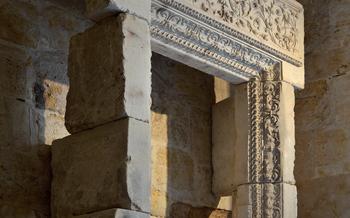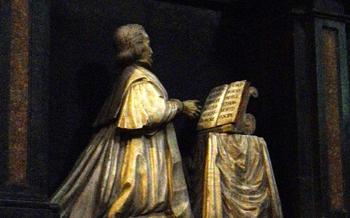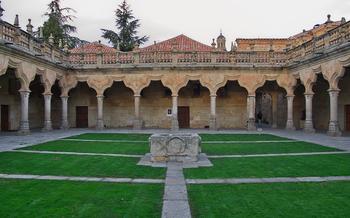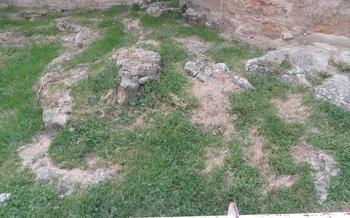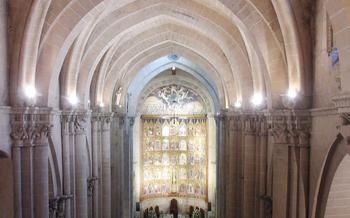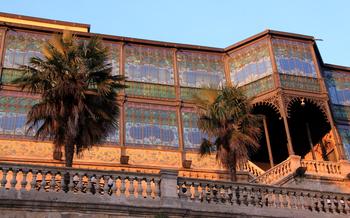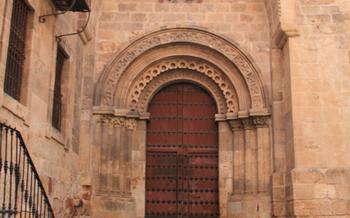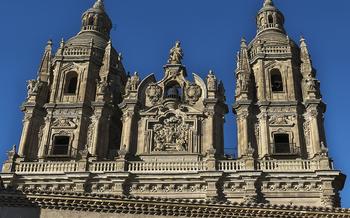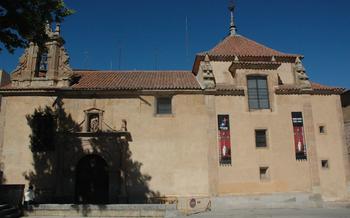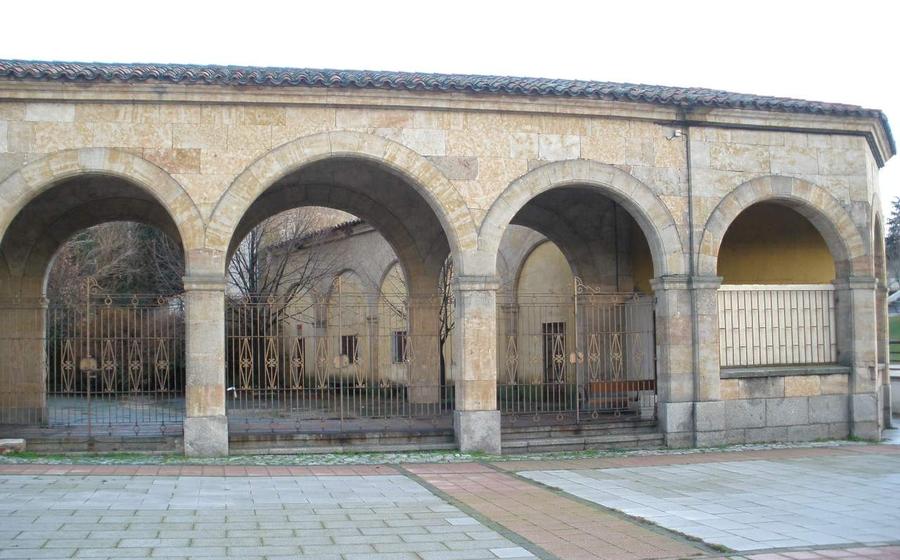
La Santísima Trinidad Church
- La Santísima Trinidad Church: An Architectural Masterpiece
- A Walk Through History: Exploring the Church's Past
- Marvelous Exterior: A Symphony of Stone
- Stepping Inside: Unveiling the Sanctuary's Splendor
- Captivating Altars: A Showcase of Artistic Treasures
- A Place of Worship and Pilgrimage: Traditions and Rituals
- Hours of Operation and Admission: Planning Your Visit
- Dress Code and Etiquette: Respecting the Sacred Space
- Guided Tours: Enhancing Your Experience
- Photography and Videography: Capturing Memories
- Accessibility for Visitors with Disabilities: Ensuring Inclusivity
- Nearby Attractions: Exploring Salamanca's Treasures
- Insider Tip: Unveiling Hidden Secrets
La Santísima Trinidad Church: An Architectural Masterpiece
La Santísima Trinidad the city's rich history and architectural prowess. Built in the 12th century, this stunning edifice has stood the test of time, bearing witness to countless events that have shaped the city's identity. Its strategic location, in the Plaza del Mercado, underscores its significance as a focal point of religious and community life in Salamanca.
The church's architectural style is a harmonious blend of Romanesque and Gothic elements, reflecting the transitional period during which it was constructed. Its sturdy Romanesque foundation is complemented by intricate Gothic details, such as pointed arches, ribbed vaults, and elegant tracery windows. The result is a captivating fusion of architectural styles that creates a sense of awe and wonder in visitors.
A Walk Through History: Exploring the Church's Past
The origins of La Santísima Trinidad Church can be traced back to the 12th century, when it was initially constructed as a Romanesque chapel. However, the church underwent significant transformations in the 16th century, when it was rebuilt in the Gothic style, reflecting the prevailing architectural trends of the era. During this period, the church became an important center of worship and spirituality for the local community.
Throughout its history, La Santísima Trinidad Church has witnessed numerous significant events and has been associated with notable figures. In the 16th century, the church served as the burial site for several prominent members of the Maldonado family, who were influential figures in the region. Additionally, the church has been a venue for various religious ceremonies and festivals, including the annual celebration of the feast day of the Holy Trinity, which attracts pilgrims and visitors from across the region.
Marvelous Exterior: A Symphony of Stone
The exterior of La Santísima Trinidad Church is a testament to the architectural prowess of its designers. The imposing façade, adorned with intricate carvings and sculptures, immediately captures the attention of visitors. The church's main entrance, framed by an elaborate archway, invites visitors to step inside and explore the wonders that lie within.
One of the most striking features of the exterior is its intricate stonework. The walls are adorned with a tapestry of carvings depicting biblical scenes, mythical creatures, and floral motifs. The level of detail and craftsmanship is simply breathtaking, showcasing the exceptional skills of the artisans who worked on the church.
The church's bell tower, a prominent feature of the skyline, is another marvel to behold. Rising high above the surrounding buildings, it offers panoramic views of Salamanca and the surrounding countryside. The tower is adorned with intricate carvings and is topped with a weather vane in the shape of a cross, symbolizing the church's dedication to its faith.
The symbolism and iconography present on the church's exterior further enhance its significance. The intricate carvings and sculptures serve as visual representations of religious teachings and stories, inviting visitors to contemplate the deeper meanings behind the church's architecture. The interplay of light and shadow on the facade throughout the day adds another layer of depth and beauty, creating a dynamic and ever-changing spectacle.
Stepping Inside: Unveiling the Sanctuary's Splendor
The interior of La Santísima Trinidad Church is a testament to the grandeur and artistry of the Renaissance period. As you step inside, your gaze is immediately drawn to the expansive nave, with its soaring arches and intricate ribbed vaults. The interplay of light and shadow creates a sense of awe and wonder, highlighting the church's impressive dimensions.
The nave is lined with a series of side chapels, each dedicated to a different saint or religious figure. These chapels are adorned with elaborate altarpieces, sculptures, and paintings, showcasing the artistic talents of the period. The main altarpiece, located at the far end of the nave, is a masterpiece of Renaissance art, featuring intricate carvings, vibrant colors, and gilded details.
The sanctuary, located behind the main altar, is the most sacred space within the church. It is separated from the nave by a magnificent rood screen, which features intricate carvings depicting scenes from the life of Christ. The sanctuary houses the tabernacle, where the consecrated host is kept, and is a place of quiet contemplation and prayer.
Throughout the church, the interplay of light and space creates a sense of serenity and spirituality. The large windows allow natural light to flood the interior, illuminating the vibrant stained glass windows and casting intricate shadows on the walls. This interplay of light and shadow adds to the church's overall grandeur and enhances its sacred atmosphere.
Captivating Altars: A Showcase of Artistic Treasures
The interior of La Santísima Trinidad Church is adorned with a series of captivating altars that serve as a testament to the artistic and religious heritage of Salamanca. The main altarpiece, a masterpiece of the Spanish Renaissance, takes center stage with its intricate carvings, vibrant colors, and gold leaf embellishments. Depicting scenes from the life of Christ and the Virgin Mary, the altarpiece is a testament to the skill and artistry of the craftsmen who created it.
Other significant altars within the church include the Altar of the Magi, featuring a stunning depiction of the Three Kings paying homage to the infant Jesus, and the Altar of the Rosary, adorned with delicate carvings and paintings dedicated to the Virgin Mary. Each altar tells a unique story, offering visitors a glimpse into the rich history and religious traditions of Spain.
The stories behind the altarpieces are as fascinating as the artworks themselves. Many of the altars were commissioned by wealthy families or religious orders, who sought to commemorate important events or honor their patron saints. The Altar of the Magi, for example, was commissioned by the Catholic Monarchs, who ruled Spain during the late 15th and early 16th centuries, as a symbol of their devotion to the Three Kings.
Exploring the altars of La Santísima Trinidad Church is like embarking on a journey through time, where each piece of art unveils a chapter in the history of this sacred space. These captivating altars, with their intricate details and profound symbolism, are a testament to the enduring power of faith and artistic expression.
A Place of Worship and Pilgrimage: Traditions and Rituals
La Santísima Trinidad Church stands as a testament to the deep religious traditions and rituals that have shaped the lives of the people of Salamanca. Throughout the year, the church hosts a variety of religious ceremonies and festivals that draw worshippers and pilgrims from across the region.
One of the most significant events in the church's calendar is the annual Feast of the Holy Trinity, celebrated on the first Sunday after Pentecost. This grand festival honors the patron saint of the church and features a solemn procession through the streets of Salamanca, accompanied by music, dancing, and traditional costumes.
In addition to regular masses and services, the church also welcomes pilgrims who come to seek spiritual guidance and solace. The church's location along the ancient Via de la Plata, a pilgrimage route that stretches from Seville to Santiago de Compostela, makes it a popular destination for those seeking spiritual enlightenment.
The church's serene atmosphere and rich history create a powerful sense of spirituality, making it a place of worship and pilgrimage that continues to inspire and uplift the faithful.
Hours of Operation and Admission: Planning Your Visit
La Santísima Trinidad Church welcomes visitors with open arms, inviting them to immerse themselves in its sacred beauty and rich history. To ensure a fulfilling experience, it's essential to plan your visit carefully.
- Opening Hours:
The church's doors are open to the public from Monday to Sunday, providing ample opportunities for exploration and contemplation. During the summer months (June to September), the church extends its hours to accommodate the influx of visitors, staying open from 9:00 AM to 1:00 PM and 4:00 PM to 7:00 PM. In the winter months (October to May), the hours are slightly shorter, with the church open from 10:00 AM to 12:00 PM and 4:00 PM to 6:00 PM.
- Admission Fees:
Admission to La Santísima Trinidad Church is free of charge, allowing visitors from all walks of life to experience its grandeur without financial barriers. This open-door policy reflects the church's commitment to sharing its spiritual and cultural treasures with the world.
-
Tips for Visiting:
-
Peak Season: During the summer months, Salamanca experiences a surge in tourism, resulting in longer queues and crowds. To avoid the hustle and bustle, consider visiting during the shoulder seasons (spring and autumn) or off-season (winter).
- Photography Enthusiasts: If you're passionate about capturing the church's beauty through photography, plan your visit during the golden hours of sunrise and sunset when the light casts a warm glow on the stonework.
- Guided Tours: Guided tours are available for those seeking a deeper understanding of the church's history, architecture, and religious significance. These tours offer insights and anecdotes that bring the church to life.
Dress Code and Etiquette: Respecting the Sacred Space
When visiting La Santísima Trinidad Church, it is important to adhere to a respectful dress code and observe proper etiquette. As a place of worship, the church maintains a sacred atmosphere that should be honored by visitors. Modest and conservative attire is recommended, avoiding shorts, tank tops, or revealing clothing that may be deemed inappropriate for a religious setting. Additionally, visitors should be mindful of their behavior within the church, maintaining a respectful silence and refraining from disruptive activities. Photography and videography are permitted, but using flash or tripods is generally not allowed. By following these guidelines, visitors can contribute to preserving the sanctity of the church while still enjoying their visit.
Guided Tours: Enhancing Your Experience
Elevate your visit to La Santísima Trinidad Church by embarking on a guided tour. Conducted in a variety of languages, these tours provide an immersive and enriching experience, allowing you to delve deeper into the church's history, architecture, and significance. Knowledgeable guides will lead you through the sacred spaces, sharing fascinating insights and anecdotes that bring the church's story to life. With a guided tour, you'll gain a profound understanding of the church's past and present, ensuring a truly memorable and meaningful visit.
Photography and Videography: Capturing Memories
The La Santísima Trinidad Church, with its awe-inspiring architecture and intricate details, is a photographer's paradise. However, it's essential to strike a balance between capturing the church's beauty and respecting the sacred space.
Photography and videography are generally permitted inside the church, but flash photography and tripods are prohibited to minimize distractions and preserve the artwork's integrity. Visitors are encouraged to be discreet and avoid disturbing worshippers or other visitors.
To capture the church's grandeur, consider using a wide-angle lens to encompass its vastness. Experiment with different perspectives, such as shooting from the back of the church to showcase the intricate details of the main altarpiece. Natural light streaming through the stained-glass windows creates stunning effects, so plan your visit accordingly.
When photographing or filming people, always ask for their permission and be respectful of their privacy. Remember, the church is a place of worship first and foremost, so it's important to maintain a contemplative atmosphere.
By following these guidelines, you can capture the essence of La Santísima Trinidad Church while respecting its sacred nature. Your photographs and videos will serve as cherished mementos of your visit, allowing you to relive the awe-inspiring beauty of this architectural masterpiece.
Accessibility for Visitors with Disabilities: Ensuring Inclusivity
La Santísima Trinidad Church welcomes visitors of all abilities and strives to provide an inclusive environment for everyone. To ensure a comfortable and enjoyable experience, the church has implemented several accessibility features:
-
Barrier-Free Access: The church's entrance is equipped with a ramp, allowing wheelchair users and visitors with limited mobility to enter the building effortlessly.
-
Accessible Seating: Inside the church, designated seating areas are reserved for visitors with disabilities, offering unobstructed views of the altar and the nave.
-
Audio and Visual Aids: For visitors with hearing impairments, assistive listening devices are available upon request to enhance their participation in religious services and guided tours.
-
Accommodating Staff: The church's staff is trained to assist visitors with disabilities, providing guidance and support throughout their visit.
-
Contact Information: To inquire about specific accessibility needs or arrange for assistance, visitors can contact the church's administration office in advance.
La Santísima Trinidad Church is committed to creating a welcoming and accessible environment for all visitors, ensuring that everyone can experience the spiritual and historical significance of this sacred space.
Nearby Attractions: Exploring Salamanca's Treasures
La Santísima Trinidad Church stands as a magnificent landmark within the vibrant city of Salamanca. Its allure extends beyond its own walls, inviting visitors to explore the city's other treasures. A short stroll from the church, the Plaza Mayor beckons with its lively atmosphere and stunning architecture, offering a glimpse into the city's rich history. The Universidad de Salamanca, one of the oldest and most prestigious universities in the world, is also a must-see, showcasing its impressive architecture and academic legacy.
For those seeking a tranquil retreat, the tranquil gardens of the Huerto de Calisto y Melibea offer a serene escape. Art enthusiasts will delight in the Museo de Art Nouveau y Art Déco, which houses a collection of exquisite decorative arts from the late 19th and early 20th centuries. Whether you prefer to explore Salamanca's historic streets, delve into its cultural heritage, or simply soak in its vibrant atmosphere, the city promises an unforgettable journey.
Creating an itinerary that allows you to experience the best of Salamanca is essential. Consider starting your day with a visit to La Santísima Trinidad Church, immersing yourself in its architectural grandeur and spiritual significance. From there, wander through the picturesque streets, admiring the city's unique blend of Romanesque, Gothic, and Renaissance architecture. Make sure to visit the Plaza Mayor, marvel at the Universidad de Salamanca's historic buildings, and find solace in the peaceful Huerto de Calisto y Melibea. As evening approaches, indulge in the city's culinary delights at one of the many charming restaurants, and conclude your day with a leisurely stroll along the banks of the Tormes River, basking in the city's enchanting ambiance.
Insider Tip: Unveiling Hidden Secrets
Beyond the obvious splendor of La Santísima Trinidad Church, there lies a hidden gem waiting to be discovered. As you wander through the church's interior, take a moment to pause and gaze upon the intricate details of the choir stalls. These beautifully carved wooden seats, often overlooked by visitors, tell their own unique story. Each stall is adorned with intricate carvings depicting biblical scenes, mythical creatures, and symbolic motifs. Spend some time deciphering the stories behind these carvings, and you'll uncover a hidden layer of meaning within the church's sacred space.
